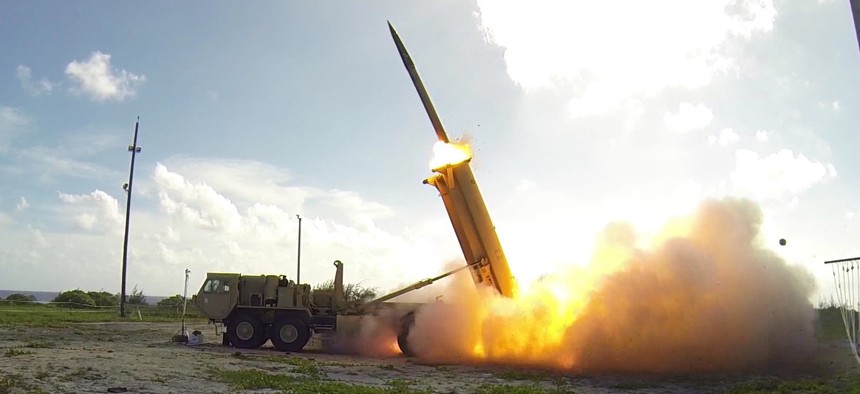
A Terminal High Altitude Area Defense (THAAD) interceptor is launched from a battery located on Wake Island during a Nov. 1, 2015 flight test.. U.S. Missile Defense Agency
Here’s What the US Could Sell South Korea and Japan to Counter North Korea
Trump doubles the allowable size of Seoul’s warheads and promises to transfer more sophisticated weapons to Asian allies.
Donald Trump tweeted Tuesday that he would allow South Korea and Japan to buy a “substantially increased amount of highly sophisticated military equipment.” Though the White House has not explained why, presumably the president hopes such transfers will help deter North Korea, which set off its sixth nuclear bomb over the weekend.
But ships and aircraft take years to build, and even less-complicated weapons may require months to boost production, so the U.S. would likely need to raid its own stockpiles to have an immediate impact. Here’s what South Korea and Japan already have in their arsenals, and what might be on their shopping list:
Missile Defense
Tokyo is planning a major missile-defense upgrade: its 2018 budget proposal requests funds for Standard Missile-3 Block 2A interceptors, PAC-3 MSE interceptors, upgrades to air and missile defense radar — and most significantly, Aegis Ashore, the land-based version of the the air-defense combat system used on many American, Japanese and South Korean warships. (It would be just the second deployment of Aegis Ashore, after one in Romania.) Roman Schweizer, an analyst with Cowen Washington Research Group, adds that Tokyo is also considering buying THAAD interceptors. Both Japan and South Korea already have Patriot air-defense missiles.
Missiles
On Monday, Trump also “gave his in-principle approval to South Korea’s initiative to lift restrictions on their missile payload capabilities.” A 2012 deal between the U.S. and South Korea had limited the latter’s missiles to 800 kilometers and warheads of 500 kilograms.
Seoul will now be able to launch warheads of 1,000 kilograms, improving its ability to destroy hardened targets, said Bruce Klingner, a former CIA deputy division chief for Korea who is now a senior research fellow for Northeast Asia at the Heritage Foundation.
“It is a proper response to the request of an ally facing a dire security threat,” Klingner said. “Doing so augments allied deterrence and defense capabilities, furthers the trend of South Korea assuming a larger responsibility for its defense, and another means of reassuring the South Korean government and public that the United States understands its ally’s defense requirements.”
The U.S. could likely transfer more powerful bombs and missiles to South Korea from its own stockpiles rather quickly. But remember: the U.S. military had already been raiding its global missile stockpiles for the three-year-old airstrike campaign against ISIS in Iraq and Syria. It’s been working to replenish its inventory.
Aircraft
Both South Korea and Japan are already buying the fifth-generation F-35 Joint Strike Fighter. South Korea plans to buy 40 F-35s, with the first arriving next year. Japan is already starting to build its own 42 planned F-35s. The two nations are also buying the Global Hawk high-altitude surveillance drone. Another possible option could be the General Atomics Avenger drone, which can fly higher and faster than propeller-powered drones and can carry 3,000 pounds of sensors or bombs. Last month David Alexander, who leads General Atomics’ Aircraft Systems division, touted the plane’s “long endurance and persistent time on station to stare on something,” as particularly useful over North Korea.
Tactical Nuclear Weapons
The most drastic possible solution for up-arming South Korea would be the deployment of new tactical nuclear weapons. These are lower-yield nukes that could be launched via rocket systems like the MGR-3 Little John artillery system. The U.S. removed all of its nuclear weapons from the Korean peninsula in the 1990s.
Over the weekend, South Korean Defense Minister Song Young-moo told a parliamentary hearing that he had a discussion with United States Defense Secretary James Mattis on the subject.
“I told him that it would be good for strategic assets to be sent regularly to the Korean Peninsula and that some South Korean lawmakers and media are strongly pushing for tactical nuclear weapons [to be redeployed],” he said according to the Washington Post. The move would be a provocative one, likely inflaming tensions with China and Russia in addition to antagonizing North Korea.
The Defense Department had not commented on Mattis’s response when reporters caught up with the secretary outside the White House on Saturday after the North Korean nuclear test. Mattis emphasized that the members of the United Nations Security Council “unanimously agreed on the threat North Korea poses and they remain unanimous on their commitment to the de-nuclearization of the Korean Peninsula because we are not looking to the total annihilation of a country, namely North Korea. As I said, we have many options to do so.”
Candidate Trump was open to the idea of allowing South Korea (and Japan) to arm themselves with nuclear weapons. And while President Trump is fond of reminding people that “all options are on the table” his view of tactical nuclear weapons as an item on the table are less well known.
On Sunday, Trump spoke with President Moon Jae-In over the phone to discuss “strengthening joint military capabilities,” according to an official readout. The capabilities the two leaders discussed include South Korean conventional missiles but not tactical nuclear weapons, a Trump Administration official said.
Some South Korean politicians from the conservative Saenuri Party have called for the country to begin its own nuclear weapons program, a move that would go against the Nuclear Non-proliferation Treaty. In February 2016, Rep. Won Yoo-chul, leader of the Saenuri argued in a floor speech, “We cannot borrow an umbrella from a neighbor whenever it rains.” On Monday, he amplified the theme in an address at the National Assembly. “We must be prepared and wear our own raincoat.”




